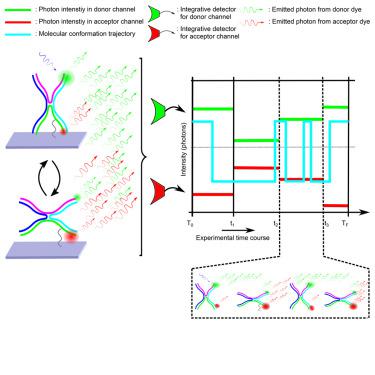Cell Reports Physical Science ( IF 7.9 ) Pub Date : 2021-04-22 , DOI: 10.1016/j.xcrp.2021.100409 Zeliha Kilic 1 , Ioannis Sgouralis 2 , Wooseok Heo 3 , Kunihiko Ishii 3, 4 , Tahei Tahara 3, 4 , Steve Pressé 1, 5, 6

|
Hidden Markov models (HMMs) are used to learn single-molecule kinetics across a range of experimental techniques. By their construction, HMMs assume that single-molecule events occur on slower timescales than those of data acquisition. To move beyond that HMM limitation and allow for single-molecule events to occur on any timescale, we must treat single-molecule events in continuous time as they occur in nature. We propose a method to learn kinetic rates from single-molecule Förster resonance energy transfer (smFRET) data collected by integrative detectors, even if those rates exceed data acquisition rates. To achieve that, we exploit our recently proposed “hidden Markov jump process” (HMJP), with which we learn transition kinetics from parallel measurements in donor and acceptor channels. HMJPs generalize the HMM paradigm in two critical ways: (1) they deal with physical smFRET systems as they switch between conformational states in continuous time, and (2) they estimate transition rates between conformational states directly without having recourse to transition probabilities or assuming slow dynamics. Our continuous-time treatment learns the transition kinetics and photon emission rates for dynamic regimes that are inaccessible to HMMs, which treat system kinetics in discrete time. We validate our framework’s robustness on simulated data and demonstrate its performance on experimental data from FRET-labeled Holliday junctions.
中文翻译:

使用集成检测器从 smFRET 测量中提取快速动力学
隐马尔可夫模型 (HMM) 用于通过一系列实验技术来学习单分子动力学。通过其构造,隐马尔可夫模型假设单分子事件发生的时间尺度比数据采集的时间尺度慢。为了超越 HMM 的限制并允许单分子事件在任何时间尺度上发生,我们必须像自然界中发生的那样在连续时间内处理单分子事件。我们提出了一种从集成探测器收集的单分子福斯特共振能量转移(smFRET)数据中学习动力学速率的方法,即使这些速率超过了数据采集速率。为了实现这一目标,我们利用了最近提出的“隐马尔可夫跳跃过程”(HMJP),通过该过程,我们从供体和受体通道的并行测量中学习转变动力学。 HMJP 以两种关键方式概括了 HMM 范式:(1)它们在连续时间内在构象状态之间切换时处理物理 smFRET 系统,(2)它们直接估计构象状态之间的转变速率,而无需求助于转变概率或假设缓慢动力学。我们的连续时间处理学习动态状态的转变动力学和光子发射速率,这是 HMM 无法访问的,而 HMM 在离散时间处理系统动力学。我们验证了我们的框架在模拟数据上的稳健性,并在 FRET 标记的霍利迪连接点的实验数据上展示了其性能。









































 京公网安备 11010802027423号
京公网安备 11010802027423号